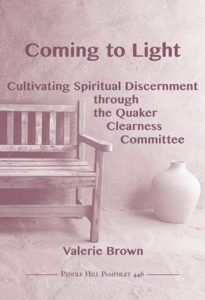Coming to Light: Cultivating Spiritual Discernment through the Quaker Clearness Committee
Reviewed by Karie Firoozmand
November 1, 2017
 By Valerie Brown. Pendle Hill Pamphlets (number 446), 2017. 27 pages. $7/pamphlet.
By Valerie Brown. Pendle Hill Pamphlets (number 446), 2017. 27 pages. $7/pamphlet.
Buy from QuakerBooks
In this short pamphlet, Valerie Brown introduces readers to the Quaker clearness committee, shares personal stories of how they have worked in her own life, and deepens the discussion into the spiritual development and formation that can result.
That’s a lot to do in 27 pages. Brown does it by starting with an acknowledgement of other existing Quaker writings on the clearness committee, which she quotes at various points. She describes briefly the development and traditional use of clearness committees for membership in and marriage under the care of a monthly meeting.
And then the fun begins. It is effective and enjoyable to learn through stories, and Brown tells stories of her own clearness committee experiences. She also recounts using the process during her training and later in her work in Center for Courage and Renewal workshops.
Coming to Light is user-friendly in several ways. Many readers are familiar with Quaker usage of ordinary English words to describe experiences in a way that is peculiar to our worship. “Waiting” and “watchfulness,” for instance, mean something different in a Quaker context, and Brown offers definitions here. Brown does use the word “God” in her writing. She does this early on, and as a reader I found it helpful to know what she meant: “For me as a Quaker and a Buddhist, God is a Spirit of Oneness; the Light or Seed Within All Things; the Energy of Compassion, Love, Understanding, and Peace.” Since this appears on page two, it helped me frame the rest of Brown’s words.
Following that is a section of the elements of the clearness committee; here is a lengthy discussion of querying, deep listening, and the role of silence. In fact, Brown even describes how a chair is placed in the circle and left empty for the presence of silence in a Courage and Renewal clearness committee. It is a powerful reminder of the role of silence: it does what no words can do in holding a space and gathering us in. It becomes holy, and so do we when we mind its power.
Early on, Brown tells us that “the clearness committee supports individual discernment within a living community” and that discernment “arises from faithfulness, unfolding over time as you cultivate your own inner spiritual landscape and relationship with God.” We come to “determine what is truly from God,” see “where God has shaped your life,” and “notice emerging patterns that might bring you closer to God.”
Since the point of clearness for discernment is no less than this, our Friends who query and listen to us are well to feel free from the desire to advise, fix, or offer help. It is here where Brown’s discussion of querying, deep listening, and silence is most helpful. Her words empower us to use this “counter-cultural” tool in ways that honor our commitment—and ability—to gather in the Spirit. As she says, because of the “intensity of presence that is the hallmark of the clearness committee,” it is possible for “committee members [to] perceive whether their own interior movement is aligned with others’ interior movement; they sense God palpably present.”
Brown includes a brief description of times in a person’s life when it is helpful to use the clearness committee and a sample format. The writing is 27 pages, but on pages 28–34 are appendices covering guidelines for asking questions, additional guidelines called “touchstones” from the Center for Courage and Renewal, reflection queries for pamphlet discussion, and endnotes.
If you think that such a short pamphlet is a sprint through a weighty subject, you will be happily surprised by this pamphlet. By treating several aspects briefly, Brown sets aside a large proportion of her text for describing the things that make clearness committees work: querying, deep listening, and silence. This short format is a gift to those of us who need introduction, teaching, and reminding. Brown’s words have power, and so does the practice she invites us to.



Comments on Friendsjournal.org may be used in the Forum of the print magazine and may be edited for length and clarity.